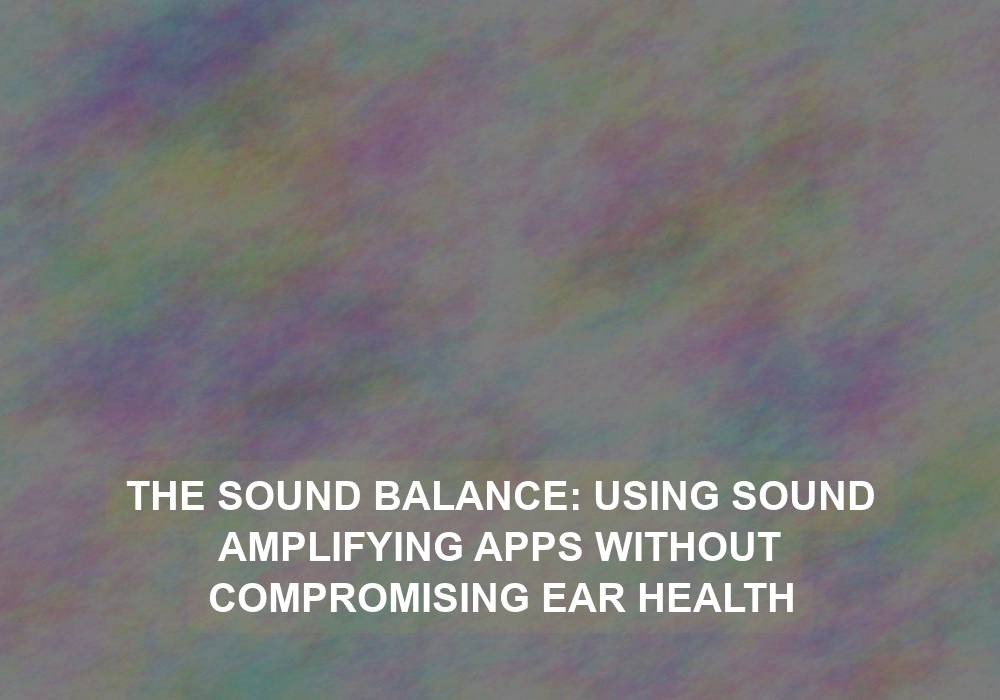In today’s technologically advanced world, smartphones have become an integral part of our daily lives. They provide us with endless opportunities to connect, learn, and entertain ourselves. With the rise of sound amplifying apps, individuals with hearing impairments are now able to enhance their auditory experiences and communicate more effectively. However, it is essential to use these apps responsibly to prevent any potential harm to our precious ear health.
Understanding Sound Amplifying Apps
Sound amplifying apps are designed to amplify the volume of sounds around us, making it easier for individuals with hearing impairments to listen and communicate effectively. These apps work by utilizing the microphone on a smartphone to capture sounds and then amplify them through the device’s speakers or headphones.
Sound amplifying apps can be a valuable tool for individuals with hearing impairments as they enhance their ability to hear and communicate in various environments. By amplifying sounds, these apps provide a clearer and more audible experience, allowing users to engage in conversations, listen to music, and enjoy other audio content.
Potential Risks to Ear Health
While sound amplifying apps can be incredibly beneficial, it’s important to be mindful of potential risks to our ear health. When using these apps, it is easy to inadvertently expose our ears to excessively loud sounds, leading to noise-induced hearing loss or other related conditions.
Excessive exposure to loud sounds can cause permanent damage to the delicate structures of the ear, including the hair cells in the inner ear. This can result in hearing loss or tinnitus, a ringing or buzzing sound in the ears. It is crucial to protect our ears from prolonged exposure to loud noises, even when using sound amplifying apps.
Best Practices for Using Sound Amplifying Apps
To enjoy the benefits of sound amplifying apps without compromising our ear health, it is crucial to follow some best practices. Here are some recommendations to ensure safe and responsible usage:
1. Consult with a Healthcare Professional
Before using any sound amplifying app, it is advisable to consult with a healthcare professional specialized in audiology. They can assess your specific hearing needs and recommend appropriate apps that are suitable for your condition. A professional can also guide you on how to use the app effectively and safely.
2. Choose High-Quality Apps
Selecting reliable and high-quality sound amplifying apps is essential. Look for apps that have positive user reviews, are regularly updated, and have been developed by reputable companies. Avoid downloading apps from unknown sources, as they may not be reliable or safe. High-quality apps often come with additional features such as customizable settings, equalizers, and noise reduction options, providing a better overall experience.
3. Set Volume Limits
Most sound amplifying apps allow users to adjust the volume according to their preferences. It is crucial to set volume limits within safe levels to prevent potential damage to your hearing. A good rule of thumb is to keep the volume at a level where you can comfortably hear the sounds without straining or experiencing any discomfort. Some apps even offer volume limiters that prevent users from exceeding safe levels.
4. Take Breaks
Continuous exposure to amplified sounds can fatigue the ears. It is important to take regular breaks when using sound amplifying apps to give your ears some rest. Taking short breaks every hour can help prevent overexposure to loud sounds and reduce the risk of hearing damage. During these breaks, try to engage in quiet activities or give your ears some silence to recover.
5. Use Headphones Wisely
If you prefer using headphones while using sound amplifying apps, make sure to choose over-the-ear headphones instead of earbuds. Over-the-ear headphones provide better sound isolation and are generally safer for your hearing. Additionally, avoid using headphones at excessively high volumes, as this can increase the risk of hearing damage. Be aware of the volume level and choose headphones that offer good sound quality without sacrificing your ear health.
6. Be Mindful of Background Noise
When using sound amplifying apps in noisy environments, it is important to be mindful of the background noise. Avoid turning up the volume to drown out the noise, as this can lead to overexposure. Instead, consider using noise-canceling headphones or finding quieter spaces to enhance your listening experience. Minimizing background noise allows you to focus on the amplified sounds without the need for excessively high volume levels.
7. Regularly Monitor Your Hearing
Pay attention to any changes in your hearing while using sound amplifying apps. If you notice any discomfort, pain, or a decline in your ability to hear, it is crucial to seek professional help immediately. Regular hearing check-ups can also help identify any potential issues early on. By monitoring your hearing, you can take prompt action if any problems arise and prevent further damage to your ears.
Conclusion
Sound amplifying apps offer an incredible opportunity for individuals with hearing impairments to enhance their auditory experiences and improve communication. However, it is essential to use these apps responsibly to protect our hearing health. By following the best practices mentioned above, we can enjoy the benefits of sound amplifying apps without compromising our ear health. Remember, your hearing is precious, so take the necessary steps to ensure its longevity and well-being.
